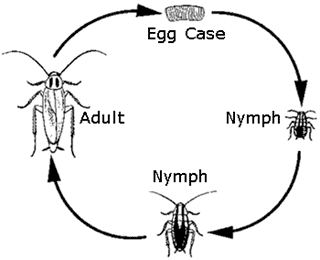PEST INFORMATION ABOUT COCKROACHES

Cockroaches (or simply “roaches”) are insects of the order Blattaria. This name derives from the Latin word for “cockroach”, blatta. There are about 4,000 species of cockroach of which 30 species are associated with human habitations and about four species are well known as pests.
Cockroaches are one of the most commonly noted household pest insects. They feed on human and pet food and damage and can leave an offensive odor.They can also passively transport microbes on their body surfaces including those that are potentially dangerous to humans, particularly in environments such as hospitals. Cockroaches infestations have been shown to be linked with allergic reactions in humans.One of the proteins that triggers allergic reactions has been identified as tropomyosin.These allergens have also been found to be linked with asthm.
COCKROACH SPECIES IDENTIFICATION
The four species of common household roaches
- A, the German roach, or Croton bug, Blattella germanica (length 9/16 inch).
- Life span of female adult 14-26 weeks
Incubation period of eggs in capsules 17-35 days
Number of offspring from one female Approx 20,000 per year
Description: Light tan to medium brown, two dark bands on pronotum, 10-15mm long.
- Life span of female adult 14-26 weeks
- B, the American cockroach, Periplaneta americana (length 1 3/8 inches).
- Life span of female adult 15-84 weeks
Incubation period of eggs in capsules 29-58 days
Number of offspring from one female Approx 800 per year
Description: Reddish to chocolate brown, light yellow band on pronotum, 30-45mm long.
- Life span of female adult 15-84 weeks
- C, the Australian cockroach, Periplaneta australasiae (length 1 1/4 inches).
- Life span of female adult 17-26 weeks
Incubation period of eggs in capsules 32-40 days
Number of offspring from one female Approx 200 per year
Description: Reddish to brown, yellow marks on pronotum and wings, 30-35mm long.
- Life span of female adult 17-26 weeks
- D, the wingless female of the Oriental roach, Blatta orientalis (length 1 1/8 inches).
- E, the winged male of the Oriental roach (length 1 inch)
- Life span of female adult 23-43 weeks
Incubation period of eggs in capsules 35-70 days
Number of offspring from one female Approx 5,000 per year
Description: Entirely brownish to black, 10-13mm long.
- Life span of female adult 23-43 weeks
PEST CONTROL: COCKROACHES
Kill the roaches. There are a variety of do-it-yourself options for killing cockroaches. Some of the more well regarded of these are listed below. Try one at a time, or try them all.
Dust with Boric Acid, Flour and Cocoa (1 part Acid, 2 parts Flour and 1 part cocoa). While still dangerous for kids and pets, this product is not as toxic as many insecticides, and the roaches aren’t repelled by it so they drag it home and feed it to their hatchlings. Dust a fine coat in cupboards, under sinks, around toilets and any cracks, corners or hollow spaces. Avoid breathing the powder; like any acid it can irritate the lungs.
Use an insecticide spray. Get some insecticide that is labeled for use against cockroaches, and spray wherever cockroaches may be hiding or entering the house, including along walls, in cracks, and in vents. Keep pets out of the way when you are spraying, and follow all safety instructions on the product’s label.
Use cockroach bait. Cockroach bait is either housed in a childproof case or applied as a gel and contains a slow-working poison mixed in with an attractive (for cockroaches) food. The roaches eat the poison and bring it back to the nest, where it eventually kills all the roaches. Place the bait in an area where you know cockroaches will encounter it.
Cockroach bait
Use cockroach traps. Cockroach traps lure cockroaches in and then trap them with an adhesive. Get several of these, and place them wherever cockroaches are known to frequent.
Use water jars. A simple and effective homemade way to lure and trap roaches is with a jar placed next to a wall, allowing the roaches to get in, but not escape. Any bait can be placed in the jar, including coffee grounds and water, but it also works with just plain water in dryer climates.
Apply a liquid concentrate. Liquid concentrates, once the exclusive domain of professional exterminators, are now being made for use by the public. The concentrate is a poison or deterrent chemical that is diluted with water and then sprayed, wiped, or mopped onto just about any surface. Concentrates can be particularly effective providing protection against re-infestation, as they usually deter roaches for 1-2 weeks or more.
Get professional grade pesticides. Don’t go to the local home improvement store, all the stuff they sell there is weak. Search the web for it. Get something with Cypermerthrin, perhaps Demon WP or something along those lines. The will kill live bugs, as well as provide a residual effect for three months. Spray it around the perimeter of your home and in places like your basement. The bugs won’t be back. The downside is that this will kill ALL bugs, even ones that eat roaches, like spiders and millipedes. But if you have lots of roaches, you probably don’t care.
Use a simple solution of Soap and Water I find this the easiest thing to do. Just make a light solution of soap (bath soap is fine) and water. You can splash this, spray this or just throw this on the roach. Just a little water will do , even 2 or 3 drops can kill, if used effectively. Ensure that it makes contact with the roaches head and lower abdomen(its belly if you can turn the roach over). The roach will run or try to run, but will suddenly stop and die or be almost dead in one minute. It is best to throw it out asap, as it may revive. This happens because the roach breathes through its skin. The soapy water forms a thin film on the breathing pores, and effectively blocks them (surface tension). So the roach will suffocate to death or to near death, but it could recover if the water dries up or has not touched a large percentage of its body. Try this and you will have amazing results for free.
- Prevent re-infestation. A clean house is key to keeping cockroaches away.
- Keep the kitchen clean. Clean up crumbs and spills promptly, and generally keep the area clean. Pay special attention to range tops, as cockroaches love grease.
- Put food away. Keep food containers sealed, and don’t leave food out for extended periods — don’t even leave dirty dishes overnight.
- Empty trash regularly, and keep trash away from the house.
- Fix dripping faucets or leaks. Cockroaches are attracted to water.
- Put naphthalene balls on corners. Roaches hate their smell.
- Prevent bugs from coming up the drain. If you believe that the cockroaches are coming up your drains, pour regular, cheap bleach down the drains before leaving the house in the morning. For a stronger solution, mix 1 part Borax with 3 parts bleach.
- Move logs and other debris away from the outside of the house. Cockroaches love piles of wood and other convenient hiding places, and as the weather turns colder, they’ll migrate inside the house to keep warm.
- Seal cracks in exterior walls. Keep roaches out of the house by blocking their entrance.
- Seal cracks everywhere you can inside your house. This takes time, but the payoff is great, because you eliminate most of their favorite hiding/breeding places. You’ll need a lot of caulking, so use the big tubes with a caulking gun. Fill every crack inside every cabinet; fill the cracks on both sides of floor, door, and window moldings; fill all openings around pipes in bathrooms and kitchens. This makes a big difference and makes the whole house feel cleaner.
- Figure out if you have cockroaches. Cockroaches (see picture) are generally medium-sized insects, although in some parts of the world they can get quite large. They have spiny legs and long antennae. If you see even one roach, you’ve undoubtedly got a lot more. The problem is they generally hide during the day, so you may need to look for them at night with a flashlight. Even if you can’t find any of the insects, check cupboards and pantries for their droppings — tiny brown slime stains or pellets.
- Try to figure out where they’re coming from. If you see cockroaches, try to follow them to figure out where they go. This is easier said than done, however, so you might need to do a little sleuthing. Check all around the house for cracks and holes through which roaches may enter. Roaches often enter through drains or vents, so you can’t seal up everything
